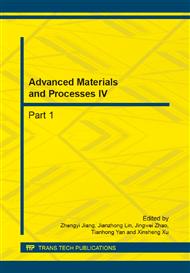p.145
p.149
p.155
p.164
p.168
p.176
p.180
p.184
p.188
Effects of Different Microalloying and Controlled Cooling Technology on Microstructure and Properties of 500MPa High-Strength Rebars
Abstract:
The mechanical properties and microstructures of three different VN, Nb, V-Nb microalloyed rebars were investigated by using tensile testing machine, impact machine, metallographic microscopy, scaning electron microcopy, transmission electron microscopy and X-ray diffraction apparatus. The results showed that the microstructure of V-Nb microalloyed specimen is consisted of ferrite, pearlite and a small amount of fine bainite (6.7wt%), and obvious effect of grain refinement was obtained with more than 10 size grade of ferrite grain, showing optimal comprehensive properties. SEM micrograph of tensile fracture surface for V-Nb microalloyed 500MPa high-strength rebar is dimple and ductile, ductile-brittle transformation temperature is lower than-30°C, which has good plasticity-toughness and impact toughness at low temperature. The results of precipitates have shown that a large number of small and dispersive V(CN) and Nb (CN) precipitates with size of 5~30nm are formed, good effect of precipitation strengthening was achieved in 500MPa high-strength rebars produced by different microalloying and controlled cooling technology.
Info:
Periodical:
Pages:
168-175
Citation:
Online since:
September 2014
Authors:
Price:
Сopyright:
© 2014 Trans Tech Publications Ltd. All Rights Reserved
Share:
Citation:


